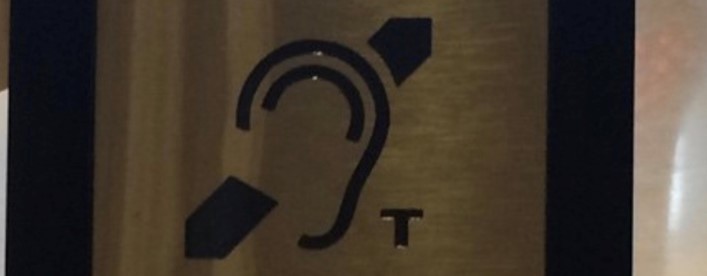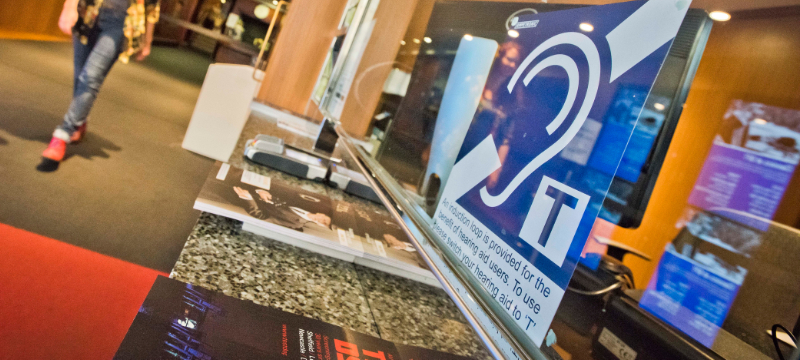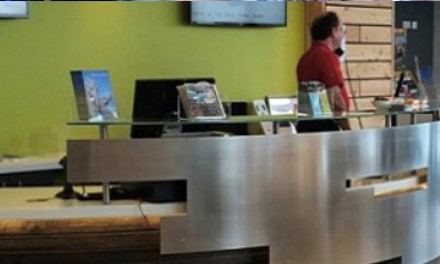Introduction to Hearing Loops


One in six people have some form of hearing loss, and around half of those use a hearing aid. This number is predicted to grow as the population ages, making understanding assistive technology to meet the requirements of people - like hearing loops - all the more vital.
The 2010 Equality Act protects people with hearing loss. It states that reasonable adjustments must be made so that disabled people are not disadvantaged compared to their non-disabled peers. The following guide briefly outlines the different types of hearing loops and how they’re used.

Image of: A man holding an ice cream wearing sunglasses with a hearing aid in his ear.
Hearing Loops
Hearing Loops are especially useful at box offices and customer service points, where you expect most face-to-face interaction between staff and customers to take place. The technology can be installed directly into a desk. Make sure to display the T and ear symbol if you have one. This is symbol is displayed on the image at the top of this webpage, and shows that a hearing loop system has been installed. The symbol depicts an ear with a diagonal stripe running across the middle and a capital ‘T’ in the bottom right corner.
What is a Hearing Loop?
Also known as an induction loop, a hearing loop is a sound system designed to help disabled people listen in loud environments. It beams sound directly into hearing aids by picking up noise with a microphone.
This signal is picked up by a receiver called a telecoil inside a hearing aid. The sound is then modified within the hearing aid to fit the wearer's individual hearing loss. The T-setting is the mechanism that allows the wearer to switch the telecoil on or off.
Types of Hearing Loops
There are several different types of hearing loops that you can use to improve the experience for hearing aid users depending on the setting and requirements.
Room Loops
These loops are used in spaces where more than one person needs to know what the speaker is saying. These include lecture style events. The loop is set up so that the signal can be picked up by people within the space. Anyone within the loop should be able to pick up the signal by switching their hearing aids to the T-setting.
Counter Loops
These loops are fitted into reception points and counters when customers speak to staff on a one-to-one basis. They are helpful in noisy environments for confidential discussions where a voice volume cannot be raised. The range for this type of loop is much shorter so the customer will need to be positioned near the loop to pick up the signal.
Screened counters can sometimes have their own speech transfer systems, but these should not replace hearing loops. Places with speech transfer systems installed should still use counter loops to help amplify what is being said.
Portable Table Tops Loops
In some situations, such as rooms where no loops have been installed, it is possible to offer the customer the use of a portable hearing loop. The sound quality of these devices varies, and they can pick up background noise, so they should only be used in quiet areas for one-on-one conversation. When you use a portable loop, the box should be between the two of you, with the label facing the customer.
Choosing the Right Hearing Loop for Your Space
When choosing the correct hearing loop for your venue, remember to consider your customer's requirements and the space where the loop is going to be used:
- Room loops are best used in environments like churches and meeting rooms where one speaker is talking to many people at once.
- Counter loops are best used in noisy environments or in areas requiring confidential discussions where voices cannot be raised.
- Portable loops have a limited range and are not recommended for anything larger than a one-on-one conversation. They are used when a fixed hearing loop has not been installed.
Installing Hearing Loops
The hearing loop you choose should be installed by someone familiar with the technical specifications. It is also important to make sure they are familiar with the relevant legislation for using them.
Hearing aid users should also be involved to verify that the system works.
Signage
It is up to you to make sure your visitors know that you have a hearing loop system in place. You should clearly display the standard hearing loop signage wherever a loop has been installed. The sign advises users to switch their hearing aid to the T-setting to make use of the hearing loop.

Image of: Signage at a box office desk letting visitors know that there is a hearing loop installed.
Testing Hearing Loops
Having a hearing loop installed is not enough, you also need to make sure your staff are trained on how to use the system and how to check that it is working.
All front-line staff including receptionists should speak clearly and be trained to notice when someone is struggling to hear or follow them. While you are open your hearing loop should be on and ready to be used so that people do not need to ask to use it. Staff using a hearing loop should know:
- How to turn hearing loops on
- How to charge portable loops
- How to use the microphone
- What the range of the hearing loop is
- How to adjust the volume
Your hearing loop can be tested by a trained member of staff using a loop listener. It is recommended that a small team of hearing aid users regularly check that the hearing loop system is functioning and providing clear, audible sound. You should also arrange annual servicing by a hearing loop technician.
Bury U3A Accessibility Study Group and Communic8te Bury have published further guidance and useful self-assessment checklists for frontline staff and managers in their ‘In The Loop’ PDF, which can be accessed for free online from Ideas for Ears' website.
In the Loop Part 2: Hearing loop awareness for frontline staff and managers
This top tips article is based on Bury U3A Accessibility Study Group and Communic8te Bury’s guidance. Special thanks to them for creating this document and specifically Hilary McColl for bringing it to our attention.










 Follow Euan's Guide on Instagram
Follow Euan's Guide on Instagram
 Follow Euan's Guide on LinkedIn
Follow Euan's Guide on LinkedIn
 Follow Euan's Guide on Facebook
Follow Euan's Guide on Facebook

